
Alstroemeriaceae is a family of flowering plants, with 254 known species in four genera, almost entirely native to the Americas, from Central America to southern South America. One species of Luzuriaga occurs in New Zealand, and the genus Drymophila is endemic to south-eastern Australia.

Banksia coccinea, commonly known as the scarlet banksia, waratah banksia or Albany banksia, is an erect shrub or small tree in the family Proteaceae. Its distribution in the wild is along the south west coast of Western Australia, from Denmark to the Stokes National Park, and north to the Stirling Range, growing on white or grey sand in shrubland, heath or open woodland. Reaching up to 8 m (26 ft) in height, it is a single-stemmed plant that has oblong leaves, which are 3–9 cm (1.2–3.5 in) long and 2–7 cm (0.8–2.8 in) wide. The prominent red and white flower spikes appear mainly in the spring. As they age they develop small follicles that store seeds until opened by fire. Though widely occurring, it is highly sensitive to dieback and large populations of plants have succumbed to the disease.

Xerochrysum bracteatum, commonly known as the golden everlasting or strawflower, is a flowering plant in the family Asteraceae native to Australia. Described by Étienne Pierre Ventenat in 1803, it was known as Helichrysum bracteatum for many years before being transferred to a new genus Xerochrysum in 1990. It is an annual up to 1 m (3.3 ft) tall with green or grey leafy foliage. Golden yellow or white flower heads are produced from spring to autumn; their distinctive feature is the papery bracts that resemble petals. The species is widespread, growing in a variety of habitats across the country, from rainforest margins to deserts and subalpine areas. The golden everlasting serves as food for various larvae of lepidopterans, and adult butterflies, hoverflies, native bees, small beetles, and grasshoppers visit the flower heads.
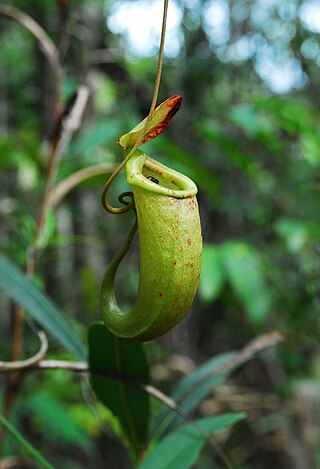
Nepenthes bellii is a tropical pitcher plant endemic to the Philippine islands of Mindanao and Dinagat, where it grows at elevations of 0–800 m above sea level.
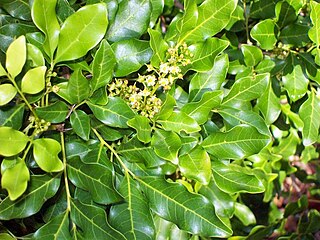
Toechima is a genus of small to medium-sized trees in the plant family Sapindaceae. The species are native to New South Wales, the Northern Territory and Queensland in Australia as well as New Guinea.

Erythrina vespertilio is a tree native to north and north-east Australia. Its common names are grey corkwood, bat's wing coral tree, yulbah and the more ambiguous "bean tree". In the Western Desert language it is known as ininti and the in Arrernte and Anmatyerr it is known as atywerety.

Peltophorum pterocarpum is a species of Peltophorum, native to tropical southeastern Asia and a popular ornamental tree grown around the world.

Ficus platypoda, commonly known as the desert fig or rock fig, is a fig that is endemic to central and northern Australia. It is a lithophytic plant that grows on rocky outcrops, reaching 10 m in height.

Ficus fraseri, the white sandpaper fig or shiny sandpaper fig, is one of several fig species commonly known as sandpaper figs. It is native to the northern and eastern coasts of Australia, and to New Caledonia and Vanuatu. Other common names are "figwood" and "watery fig".
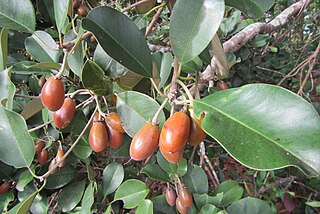
Manilkara kauki is a plant in the subfamily Sapotoideae, and the tribe Sapoteae of the family Sapotaceae; and is the type species for the genus Manilkara. It occurs in tropical Asia from Indo-China to Malesia ; and also in northern Queensland in Australia. In Java, the plant is called sawo kacik, and is associated with the royal Javanese ritual. In India, the fruit is called adão in Konkani. Throughout the world it is known generally by the name caqui, but in Australia it is called wongi.

Gymnoschoenus sphaerocephalus, commonly known as buttongrass, is a species of tussock-forming sedge from southeastern Australia. It forms part of a unique habitat in Tasmania.

Nauclea orientalis is a species of tree in the family Rubiaceae, native to Southeast Asia, New Guinea, and Australia. It has many common names, including bur tree, canary wood, Leichhardt pine and yellow cheesewood. It grows to a maximum of around 30 m (98 ft) in height and has large glossy leaves. It bears spherical clusters of fragrant flowers that develop into golf ball-sized edible but bitter fruits. The yellowish to orange soft wood is also used for timber and in woodcarving and folk medicine.

Pyrostegia venusta, also commonly known as flamevine or orange trumpet vine, is a plant species of the genus Pyrostegia of the family Bignoniaceae originally native to southern Brazil, Bolivia, northeastern Argentina and Paraguay; today, it is also a widely cultivated garden species.

Ceriops tagal, commonly known as spurred mangrove or Indian mangrove, is a mangrove tree species in the family Rhizophoraceae. It is a protected tree in South Africa. The specific epithet tagal is a plant name from the Tagalog language.

Toechima daemelianum, commonly known as cape tamarind, is an evergreen tree from north-east Queensland in Australia. It grows up to 13 metres high and a trunk which may be up to 20 cm wide.

Epicharis parasitica, commonly known as yellow mahogany, is a species of rainforest tree in the family Meliaceae native to Taiwan, parts of Malesia, Papuasia, and northeast Queensland.

Toechima monticola, also known as mountain tamarind, is a species of plant in the lychee family that is endemic to Australia.

Toechima erythrocarpum, also known as pink tamarind and foambark, is a species of plant in the lychee family that is native to Australia and New Guinea.
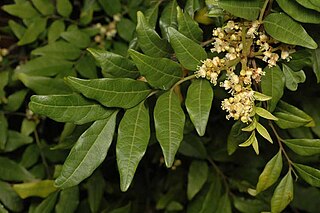
Toechima dasyrrhache, also known as blunt-leaved steelwood, is a species of plant in the lychee family that is endemic to Australia.
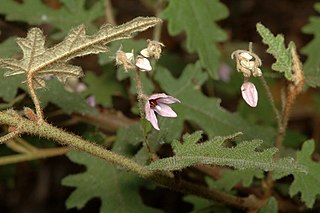
Lasiopetalum pterocarpum, commonly known as wing-fruited lasiopetalum, is a species of flowering plant in the family Malvaceae and is endemic to a restricted area in the south-west of Western Australia. It is an open shrub with many densely hairy stems, egg-shaped and lobed leaves and pink and dark red flowers.





















